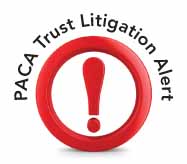 According to a recent FDA guidance document, the FDA’s risk-based model for prioritizing inspections of food establishments utilizes technology to analyze traditionally available information and to set the agency’s priorities for allocating domestic inspection resources.
According to a recent FDA guidance document, the FDA’s risk-based model for prioritizing inspections of food establishments utilizes technology to analyze traditionally available information and to set the agency’s priorities for allocating domestic inspection resources.
What does this mean in layman’s terms?
It means the FDA is going to analyze the data it already collects, tracks and monitors to determine the agency’s priorities when it comes to identifying food facilities to inspect.
How does the FDA identify a high-risk facility?
The answer to this question is two fold. First, the FDA looks at inherent risk factors at the industry wide level. The industry wide risk factors include, but are not limited to:
- foodborne illness outbreaks
- recalls
- reports of adverse events associated with a specific industry of category of food (i.e. cantalope, sprouts, etc.)
Secondly, (and most importantly) the FDA looks at inherent risk factors at the firm or company level. The firm or company level risk factors include, but are not limited to:
- the known safety risks of the food manufactured, processed, packed or held at the facility. (i.e. if your facility handles high-risk food(s) your facility will be deemed a high-risk facility based on that fact alone)
- compliance history of the firm or company (i.e. food recalls, outbreaks of foodborne illnesses and prior violations of food safety standards)
- the rigor and effectiveness of your hazard analysis and risk-based preventative controls.
- whether the food manufactured, processed, packed or held at the facility meets the criteria for priority under section 801(h)(1) of the FD&C Act, which relates to the prioritization to detect intentional adulteration in food offered for import into the U.S. (applies only to foreign food facilities)
- whether the food or the facility the manufactured, processed, packed or held such food has received a certification from the FDA under the foreign supplier verification program or the voluntary qualified importer program.
- anything else the FDA deems necessary and appropriate. Two known examples include the establishment type / type of activity conducted at the facility (i.e. manufacturer/processor, repacker/packer, etc.) and the number of years since last inspection.
How is the information used to determine inspection priority?
The FDA’s decision-making process is based primarily on the first two bullets and the last. The balance of the risk factors will be incorporated into the FDA’s decision-making process as they continue to develop their data collection and testing tools and will be laid out in the forthcoming Preventative Controls regulation.
In addition, the FDA may inspect facilities more often than the frequency mandate as a result of emerging public health information, follow-up to violative inspections and/or samples, etc.
From a technical position, the FDA is utilizing “a software program that assesses the characteristics of each facility in the agency’s inventory.” This “software provides data access, analysis and reporting from the agency’s internal data systems.” See Domestic Facility Risk Categorization
What does all of this mean to my business?
The FDA estimates that there are approximately 22,325 domestic high-risk (HR) food facilities and about 60,000 non high-risk (NHR) domestic food facilities. FSMA calls for all HR domestic food facilities to be inspected within five years of the date the bill was signed into law. Thereafter, all HR food facilities will be inspected once every three years and all NHR food facilities will be inspected once every five years. Importantly, FSMA limits its inspection of food facilities to only those required to register under the Section 415 of the FD&C Act, which is the Bioterrorisim Act.
Food companies would be well advised to start preparing for inspections NOW before the USDA comes knocking. A company may proactively mitigate many of the FDA’s risk factors through preparation. For example, there should be no excuse for a food company not to:
- be properly registered under the Bioterrorism Act.
- have the proper food safety plans and related standard operating procedures prepared and ready for inspection.
- be in compliance with many of the already known food safety rules.
- possess a solid understanding of how to manage a FDA inspection
- and more…






